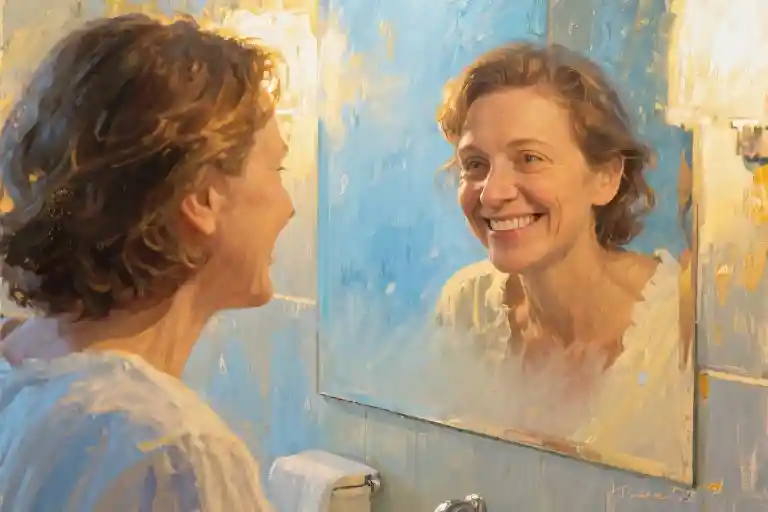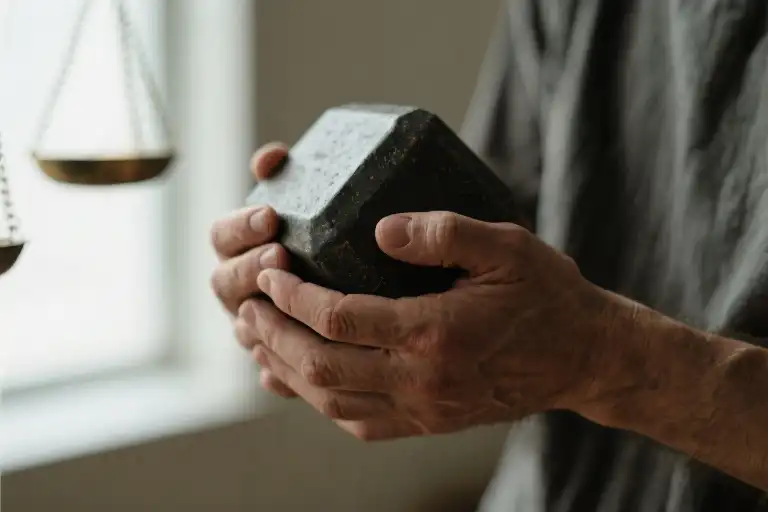The reflection staring back at me holds a quiet dissonance. This face—these lines tracing unfamiliar paths across my forehead, the subtle droop where taut skin once lived—belongs to someone I should know intimately. Yet in this moment, the woman in the mirror feels like a slightly out-of-focus photograph of myself.
I catch myself performing an odd little experiment, something I’ve done since adolescence: I smile. Not the polite social smile, but the unguarded grin that used to make my cheeks ache after childhood mischief. And there it is—the crooked incisor nudging my upper lip, the asymmetrical dimple that always made my face look lopsided in photos. This smile remains stubbornly unchanged, a rebellious constant amid the shifting landscape of my face.
That flash of recognition makes the surrounding unfamiliarity more pronounced. My eyes still crinkle at the corners when amused, but now they’re framed by fine lines that don’t smooth out when my expression relaxes. The contours of my jawline, once so sharply defined I could trace them blindfolded, have softened into something resembling my mother’s profile at this age.
This confrontation happens most mornings now, this silent negotiation between expectation and reality. The brain takes milliseconds longer to recognize aged faces—studies from Cambridge confirm what midlife women have always known. We become strangers to ourselves by degrees, each small change accumulating until one day the cumulative effect demands acknowledgment.
There’s an intimacy to this particular grief that’s difficult to articulate. We mourn not just the loss of youth’s aesthetic, but the gradual fading of what once felt like a fixed point in our personal universe. That face at twenty-five—freshly shed of childhood’s roundness, bearing the first marks of earned experience—became the mental blueprint against which all subsequent versions would be measured. Now that template feels outdated, like trying to navigate with last decade’s map.
Yet in quiet moments, brushing teeth or wiping steam from the mirror, I catch glimpses of continuity. The way my left eyebrow still arches higher when skeptical. The faint scar above my lip from a long-forgotten playground incident. These persistent markers become lifelines, proof that beneath the shifting surface, some essential self endures.
Perhaps this is the paradox of aging we seldom discuss: the simultaneous alienation from and deepening acquaintance with ourselves. With each passing year, we shed another skin of who we were while accumulating new layers of who we’re becoming. The mirror reflects not just a face in flux, but an ongoing conversation between past and present selves.
The Stranger in the Mirror
The reflection blinks back at me with an expression I can’t quite place. It’s not the sudden shock of seeing a gray hair or the slow creep of crow’s feet – those changes came with warning. This is different. The woman in the glass wears my skin but carries herself like someone I’ve only met in passing. My fingers press against the cold surface as if testing its reality.
That’s when I try the smile. Not the polite one reserved for grocery clerks, but the real one that crinkles my nose and shows the slightly crooked tooth I’ve refused to fix since college. And there she is – the ghost of my younger self flickering beneath the surface. Psychologists call this ‘self-face recognition delay,’ our brain’s stubborn insistence that we still look twenty-five even as the mirror argues otherwise. Cambridge researchers found it takes milliseconds longer to process aging features, as if our neural pathways are protesting the evidence.
This dissonance began decades ago, though I didn’t recognize it then. At twelve, I’d stare at my changing reflection with fascination, not fear. At twenty-five, I mourned the loss of baby fat but welcomed the sharpening jawline as proof I’d finally become A Real Adult. Now the mirror shows geography I haven’t learned to navigate – valleys where smooth plains once stretched, tributaries branching from the corners of my eyes.
What fascinates me most isn’t the changes themselves, but how they’ve crept past my internal watchman. Some mornings I’ll catch a glimpse and think ‘when did that happen?’ as if my face changed overnight without permission. The phenomenon has less to do with vanity than with the peculiar way humans experience time – we’re excellent at marking others’ aging while remaining blind to our own until the evidence becomes undeniable.
Neuroscientists suggest this blindness serves as psychological protection. If we saw every minute transformation, the cumulative effect might overwhelm. Better to adjust in increments, each small change absorbed before the next arrives. Yet in rare moments like this one, the veil lifts and I see the full arc of time’s work all at once – not as a crisis, but as a strange gift of clarity.
The bathroom light hums overhead as I lean closer. This face may be unfamiliar today, but given time, we’ll become acquainted. After all, we have decades of practice at this dance – me and the woman in the mirror, learning each other anew with every passing season.
Time Travel Through My Face
The mirror has been my reluctant time machine for decades. At twelve, I first noticed its peculiar magic – how it reflected not just my face, but some emerging version of myself I didn’t yet know. My cheeks still carried childhood’s softness, but my eyes had begun holding questions too large for my small frame. That was the year I learned mirrors could lie through omission, showing the surface while hiding the seismic shifts beneath.
By twenty-five, the transformation felt complete. The last traces of baby fat had melted into sharper angles, leaving what I thought then was my “final” face. I remember tracing my jawline with fingertips, marveling at this foreign terrain that somehow belonged to me. The changes felt like promotions then – visible proof I’d graduated into proper adulthood. Little did I know this was merely the intermission between acts.
Now when I look, time’s work is undeniable. Those first fine lines that appeared like faint pencil sketches in my thirties have deepened into permanent ink. My skin, once taut as a drum, now moves in ways that surprise me when I speak. The most startling changes aren’t in any single feature, but in their collective arrangement – the geography of my face slowly rearranging itself without my permission.
What fascinates me most are the landmarks that remain. The slight crook in my nose from a childhood accident still tells its old story. My eyebrows arch in the same skeptical pattern they’ve always known. These persistent details become anchors in the storm of transformation, proof that while the map changes, the territory remains mine.
Between these milestones stretch countless micro-changes – the gradual fading of freckles, the slow migration of hairline, the subtle sinking of contours. We never notice them happening, only their accumulated effect. Like watching a tree grow by staring at it for decades, the daily differences escape us until one morning we wake up to an unfamiliar canopy.
The cruelest twist isn’t the changes themselves, but how our minds cling to outdated self-images. We carry mental snapshots that no longer match the mirror’s evidence, creating that jarring disconnect when reality intrudes. Perhaps this explains why friends’ aging seems natural while our own feels like betrayal – we witness their gradual transformation while missing our own daily increments.
Yet in quiet moments, when the light falls just so, I catch fleeting glimpses of all my former selves. The determined set of my mouth that first appeared during college exams. The laugh lines earned during years of shared jokes. Even the shadow of that twelve-year-old’s wonder sometimes flickers behind my eyes. The face in the mirror isn’t one woman, but many – a living archive of every version I’ve been.
This realization brings unexpected comfort. However foreign my reflection may seem some mornings, it carries the indelible imprint of every laugh, every sorrow, every ordinary day that shaped me. The wrinkles aren’t invaders, but witnesses. The changes aren’t erasures, but additions. My face hasn’t been taken from me – it’s been written on, layer by layer, year by year. And the story isn’t finished yet.
The Smile That Survives
The mirror may show a face I barely recognize these days, but when my lips curve upward in that particular way – slightly lopsided, revealing the same crooked tooth that’s always made my smile asymmetrical – something remarkable happens. That fleeting expression cuts through the fog of unfamiliarity like sunlight breaking through clouds. It’s not the face of my twenties or even my thirties, but the smile? The smile remains stubbornly, comfortingly mine.
Researchers call this phenomenon ‘body memory’ – those physical traits that persist through decades of change, serving as psychological anchors in our evolving self-perception. Dr. Eleanor Weston, a cognitive psychologist specializing in aging studies, explains: ‘The human brain seeks continuity amidst change. Familiar gestures like a characteristic smile or eyebrow raise create neural pathways so deeply ingrained, they become reliable touchstones when external appearances shift.’
Consider the elements that withstand time’s alterations:
- The architecture of expression: The exact angle your lips form when genuinely amused, a pattern established in childhood and refined through years of laughter
- Ocular signatures: That particular sparkle in your eyes when delighted – not the brightness of youth, but the depth of accumulated joy
- Kinetic fingerprints: The way your nose scrunches slightly when smiling broadly, a detail so small yet so distinctly you
These enduring traits form what French psychologists term ‘le soi physique permanent’ – the permanent physical self. Unlike wrinkles or gray hairs that announce our progression through years, these subtle consistencies whisper reassurances: while the container changes, the essence persists.
My dental hygienist once remarked, ‘You have the same smile at forty as in your college photos – just with more laugh lines around it.’ At the time, I focused on the mention of wrinkles. Now I understand the profound gift in her observation: my smile hadn’t disappeared beneath time’s markings; it had simply gathered context.
The psychological power of recognizing these unchanging elements can’t be overstated. In a University of California study, participants who identified persistent facial traits showed 30% higher self-acceptance scores when confronting aging. The researchers concluded: ‘Focusing on what remains familiar provides emotional ballast during physical transition.’
Perhaps this explains why, on difficult days when the mirror feels particularly unkind, I instinctively smile – not to feign happiness, but to reconnect with the most timeless version of myself. That crooked-toothed grin becomes both compass and comfort, a bridge between who I was and who I’m becoming.
This awareness shifts the aging narrative from loss to continuity. Those laugh lines? They’re not just wrinkles – they’re the fossilized evidence of countless authentic smiles. The slight droop at my eyelids? Not mere sagging skin, but the gentle curtain framing eyes that still light up the same way when seeing old friends or hearing favorite songs.
As we move toward discussing practical acceptance tools, carry this thought: your most powerful ally against aging anxiety might be the very expression you’ve worn since childhood. Tomorrow when you face the mirror, try the smile test. Not the performative kind for photographs, but the real one – the smile that surfaces unbidden when recalling a private joke or receiving unexpected kindness. Notice how, regardless of changing contours, some essential you always shines through.
Rewriting the Aging Narrative
The mirror reflects more than skin—it shows the stories we tell ourselves. That moment of unfamiliarity when facing our reflection isn’t just about changing features; it’s about the silent negotiation between who we were and who we’re becoming. This chapter isn’t about reversing time, but about reframing our relationship with it.
The Mirror as a Mindfulness Tool
Try this tomorrow morning: Before reaching for your skincare products, stand bare-faced before your mirror for three intentional breaths. Notice without judgment:
- The topography of your face—not as flaws, but as elevation maps of laughter and concentration
- The quality of light in your eyes that no wrinkle can dim
- The way your expression softens when you consciously relax your forehead
French dermatologist Dr. Élise Laurent calls this le rituel du miroir—a practice where women observe their faces not to critique, but to witness. “When patients stop seeing their skin as a problem to solve,” she notes, “their entire posture changes within weeks.”
Cultural Lenses on Time’s Imprint
In Seoul’s Gangnam district, the “anti-aging” industry thrives with clinics offering “baby skin” laser treatments. Meanwhile, Parisian women proudly call their wrinkles les rides de sagesse (wisdom lines). Neither approach is wrong—they simply represent different cultural conversations about value and visibility.
Consider:
- Japanese mono no aware—the bittersweet appreciation of impermanence
- Italian bella figura—the art of presenting one’s best self at any age
- Brazilian mulher madura—the celebration of mature women’s confidence
These perspectives don’t erase the discomfort of aging, but they expand our emotional vocabulary for it.
The Professional Face
A former ballet dancer once told me, “Retiring at 35 felt like losing my face twice—first from the stage lights, then from my own expectations.” Career transitions often accelerate our reckoning with aging. The corporate lawyer noticing clients subtly shifting to younger associates. The actress navigating “character roles.” These professional mirrors reflect societal attitudes we must consciously filter.
Rebuilding identity after such shifts requires:
- Separating market value from self-worth
- Curating role models who’ve navigated similar transitions
- Creating new metrics for success beyond visual perception
Your Face as Archive
Every morning when you wash your face, you’re touching living history. That faint scar from childhood bicycle adventures. The laughter lines from inside jokes with old friends. The slightly uneven eyebrows that give your face its distinct character. These aren’t flaws—they’re the marginalia of your life’s manuscript.
Try keeping a “face journal” for one week:
- Morning: Note one feature you’re grateful still functions (eyes that read, lips that kiss)
- Evening: Record one emotion your face expressed today without your conscious effort
You’ll likely discover what researchers at Oxford found: People who engage with their reflection this way report 23% less appearance-related anxiety after just seven days.
The Next Reflection
Tomorrow’s mirror will show someone slightly different than today’s—that’s the contract of being alive. But beneath the shifting surface, your essential grammar remains: the way your nose crinkles when genuinely amused, how your left eyebrow lifts higher than the right when skeptical. These are your constants in the changing narrative.
Perhaps the question isn’t “Do I recognize this face?” but “What new stories will this face help me tell?” After all, the most interesting novels aren’t those with unchanged characters, but those where transformation reveals unexpected depths.
The Mirror’s Gentle Truth
The mirror still hangs in its usual spot, but the reflection feels different today. That fleeting moment of recognition when I smile hasn’t erased the fundamental strangeness of this face. Yet something subtle has shifted in these past weeks of writing and reflection. The unfamiliar contours no longer shock me with quite the same intensity.
Perhaps this is how aging works – not as a single catastrophic event, but as countless small surrenders. We don’t lose our younger selves all at once, but in gradual concessions that eventually accumulate into acceptance. That first gray hair plucked becomes the silver streak we eventually stop dyeing. The wrinkle we once stretched with our fingers becomes a familiar landmark in our morning routine.
My smile experiment taught me something unexpected. While we obsess over what’s changing, our deepest connections to self reside in what remains. The crooked teeth my childhood orthodontist never fully corrected. The way my left eye crinkles more than the right when I laugh. These aren’t flaws frozen in time, but living proof of continuity amidst transformation.
Psychology tells us our brains struggle to process aging faces – our own most of all. There’s comfort in knowing this dissonance is universal, that every woman eventually confronts this mirror moment. The French call it “bien dans sa peau” – being comfortable in one’s skin. Not resisting time’s passage, but moving through it with something resembling grace.
So I propose we try something together. Tomorrow morning, before the day’s demands intrude, stand before your mirror and look – really look. Not at the new lines or shifting contours, but for that one enduring feature that still feels like you. Maybe it’s your grandmother’s nose finally emerging. Maybe it’s the same determined set to your jaw that carried you through college exams. Find that anchor point, then let your gaze soften until the stranger and the familiar self coexist.
Because here’s the secret no skincare ad will tell you: that woman in the mirror isn’t replacing your younger self. She’s containing all your previous versions like concentric rings in a tree. The girl who loved strawberry lip gloss. The young professional who mastered power suits. The new mother who survived on three hours sleep. They’re all still there, just further from the surface.
When you’re ready, I’d love to hear what you discover in your own mirror. What survives the years in your reflection? What surprised you about the face you’re growing into? Share your story using #TheSmileTest – because sometimes the most revolutionary act is simply witnessing each other’s ordinary transformations.
One last question to carry with you: If your reflection could speak with the wisdom of all your accumulated years, what would it tell today’s version of you?





